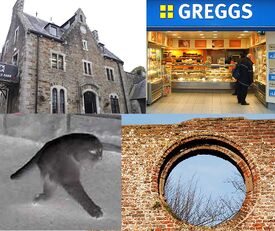Bodmin
| Zackly | |
 (Clockwise from left: Bodmin gaol, a scouser favorite for lodging; original machine-made Cornish pasties for sale; the Great Wall of Cornwall (good ventilation, not great at protection); the Beast of Bodmin Moor caught on night vision camera. | |
Previous name(s) |
Bosvenegh (to 1231), Ods Bodmin (to 1647), Bodminimum (to 1969) |
|---|---|
| Nicknames(s) | Home of The Beast |
| Administrative status | |
| Nation | Engalund |
| Region | Cornwall |
Ceremonial county |
Cornwall yet again. Coincidence? |
| Statistics | |
| Population | 14,227 plus 1 beast |
| World rank | 533th (8th beastiest) |
| Founded | yes |
| Features | pasties, rumour, innuendo, Beast poop |
Bodmin is a pleasant and affulent market town in the small independant country of Cornwall. Its many attractions and cultural diversity attract a large number of tourists, or 'emmetts', during the Cornish summer, which can last as long as eight or nine days. It is home to world-reknowned Camel Trail, which hosts the famous annual Bodmin-Dakar camel race, as well as the Bodmin Gaol, housing English 'emmetts' who outstay their tourist visas.
History[edit]
Bodmin was invented in 1969 by a wandering tribe of Scousers who had outstayed their welcome in their native land and got lost on their pilgrimage to the promised land of Plymouth. Prior to this date, the town was known as Bodminium and was populated by the indigenous tribe of Bodminites. The Bodminites still reside within the town, but are now in the minority and are a legally protected species. The Scousers built their ghettos within the ancient walls of Bodminium, and lived on the generousity of the Bodminites, who paid for their housing and provided them with a regular income by way of 'giros'. The Scousers repaid this hospitality by introducing the Bodminites to aspects of Scouse culture such as burglary, car theft and class A drugs.
Language and customs[edit]
The Cornish language, or 'Kernewick' is still used on a day-to-day basis by the Bodminites, mainly to confuse the Scousers and emmetts, who cannot understand it. This ancient tongue is difficult for the visitor to adapt to at first, but with a few simple phrases an articulate 'outsider' can converse in basic terms with a Bodminite.
For example:
Hello. How are you? - Reet mi luvva, 'oow be doin'?
I shall attend to that shortly - 'Dreckly
Good/very much so - Proper
Excellent work - Proper job
I am displeased with that person - 'Eee's proper twat
It is customary among Bodminites and Scousers alike to force their offspring out of the house every evening from their 10th birthday. These children roam the streets in packs of up to 30 youngsters. In order to avoid boredom, these public-spirited children seek out good deeds to perform in their community. They can often be seen repainting town buildings, pruning the many large trees and shrubs in the town's parks and removing unwanted items littering the streets: pedal cycles, road furniture, car stereos, etc.
Food and drink[edit]
The staple food of the Bodminites is the famous Cornish Pasty. These delectable morsels are made in local houses and small bakeries throughout the nation of Cornwall. By far the most traditional and delicious of these are made by the tiny local bakery of Ginsters. Other varieties of pasty are eschewed by true Cornish afficianado as a cheap and nasty copy of the real thing.
Bodminites do not drink water out of religious principle, but instead have vast tanks of White Lightning cider in the roofs of their homes, which feed the taps. Baths are rarely taken, so this does not create a problem.
Diversity[edit]
A recent influx of migrants from Poland and Portugal has enriched the cultural diversity of Bodmin. A shortage of qualified pasty crimpers and processed food operatives has led to Bodmin attracting applicants for these highly paid and prestigious jobs from over its borders. After an initial period of three months in quarantine, these international professionals happily take up work in Bodmin's many modern, clean, and well-paying food factories. Meat and other products from these establishments is regularly served in three-Michelin-starred restaurants as far afield as Nanstallon and Bugle.
These happy-go-lucky migrants have enriched Bodmin with their cultural and traditional values, bringing the joys of shoplifting and drink-driving to the populance.
Attractions[edit]
Bodmin is rightly famous for its Camel Trail, a high-speed escalator linking low-lying Padstein to the mountainous plateau of Bodmin. Emmetts queue for hours to ride this miraculous feat of engineering. However, this attraction is not the only highlight of a trip to Bodmin. Other notable sites of interest include:
The Berryfields Community Centre[edit]
Here, Bodminites, chavs, emos and Scousers can unite in a friendly game of bingo before visiting one of the many bars and fine restaurants of Bodmin for a nice evening of good company and intelligent conversation, often rounded off with a good old-fashioned street brawl outside the Weavers. St. John's Ambulance is always on standby but its crews often can't resist jumping in to get a taste of someone that hasn't yet experienced the thrilling ride to the nearest A&E.
Bodmin County Lunatic Asylum[edit]
Whilst no longer named as such in order to be politically correct, this historic building still exists, renamed Bodmin Bus Station. It retains its characteristic flavour and odours. Fans of screaming, wailing and oddball behaviour outside of Parliament can spend hours here, if not already permanent residents.



